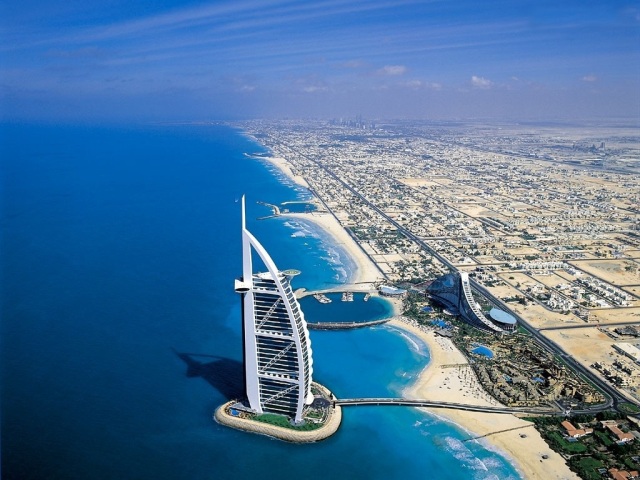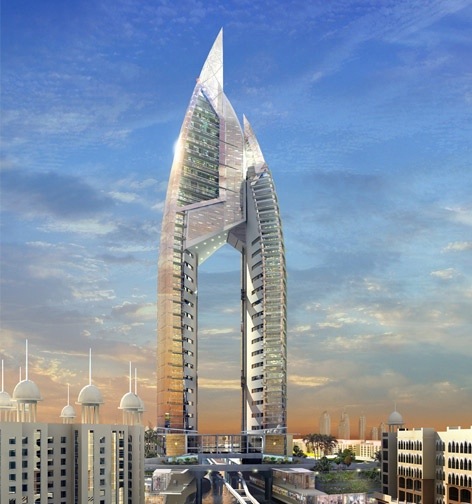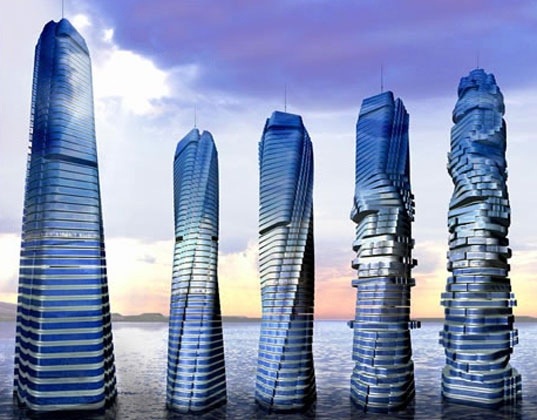Dubai, is my favorite city for a couple of reasons. But, the most important is the fact that lots of its buildings have annawesome architectural design, and that they are as high as they could be.. Here is just some info on this awesome place 😀
INFO
Dubai is a sovereign state known as the emirate in the United Arab Emirates (UAE). A city within the emirate is also named Dubai. The emirate is located south of the Persian Gulf on the Arabian Peninsula and has the largest population with the second-largest land territory by area of all the emirates, after Abu Dhabi. Dubai and Abu Dhabi are the only two emirates to have veto power over critical matters of national importance in the country’s legislature. Dubai City is located on the emirate’s northern coastline.
The earliest mention of Dubai is in 1095, and the earliest settlement known as Dubai town dates from 1799. Dubai was formally established in 1833 by Sheikh Maktoum bin Buti al Maktoum when he persuaded 800 members of the Bani Yas tribe, living in what is now part of Saudi Arabia, to follow him to the Dubai Creek by the Al Abu Falasa clan of Bani Yas. It remained under clan control when the United Kingdom assumed the protection of Dubai in 1892. Its geographical location made it an important trading hub and by the beginning of the 20th century, it was an important port.
GEOGRAPHY
Dubai is situated on the Persian Gulf coast of the United Arab Emirates and is roughly at sea level (16 m/52 ft above). The emirate of Dubai shares borders with Abu Dhabi in the south, Sharjah in the northeast, and the Sultanate of Oman in the southeast. Hatta, a minor exclave of the emirate, is surrounded on three sides by Oman and by the emirates of Ajman (in the west) and Ras Al Khaimah (in the north). The Persian Gulf borders the western coast of the emirate. Dubai is positioned at 25.2697°N 55.3095°E and covers an area of 1,588 sq mi (4,110 km2), which represents a significant expansion beyond its initial 1,500 sq mi (3,900 km2) designation due to land reclamation from the sea.
Dubai lies directly within the Arabian Desert. However, the topography of Dubai is significantly different from that of the southern portion of the UAE in that much of Dubai’s landscape is highlighted by sandy desert patterns, while gravel deserts dominate much of the southern region of the country. The sand consists mostly of crushed shell and coral and is fine, clean and white. East of the city, the salt-crusted coastal plains, known as sabkha, give way to a north-south running line of dunes. Farther east, the dunes grow larger and are tinged red with iron oxide.
The flat sandy desert gives way to the Western Hajar Mountains, which run alongside Dubai’s border with Oman at Hatta. The Western Hajar chain has an arid, jagged and shattered landscape, whose mountains rise to about 1,300 meters in some places. Dubai has no natural river bodies or oases; however, Dubai does have a natural inlet, Dubai Creek, which has been dredged to make it deep enough for large vessels to pass through. Dubai also has multiple gorges and waterholes which dot the base of the Western Al Hajar mountains. A vast sea of sand dunes covers much of southern Dubai, and eventually leads into the desert known as The Empty Quarter. Seismically, Dubai is in a very stable zone—the nearest seismic fault line, the Zagros Fault, is 200 km (124.27 mi) from the UAE and is unlikely to have any seismic impact on Dubai. Experts also predict that the possibility of a tsunami in the region is minimal because the Persian Gulf waters are not deep enough to trigger a tsunami.
CLIMATE
Dubai has a very hot arid climate. Summers in Dubai are extremely hot, windy and humid, with an average high around 42 °C (108 °F) and overnight lows around 29 °C (84 °F). Most days are sunny throughout the year. Winters are warm with an average high of 23 °C (73 °F) and overnight lows of 14 °C (57 °F). Precipitation, however, has been increasing in the last few decades with accumulated rain reaching 250 mm (9.84 in) per year. Dubai summers are also known for the high humidity level, which can make it uncomfortable for many.
ARCHITECTURE
Dubai has a rich collection of buildings and structures of various architectural styles. Many modern interpretations of Islamic architecture can be found here, due to a boom in construction and architectural innovation in the Arab World in general, and in Dubai in particular, supported not only by top Arab or international architectural and engineering design firms such as Al Hashemi and Aedas, but also by top firms of New York and Chicago. As a result of this boom, modern Islamic – and world – architecture has literally been taken to new levels in skyscraper building design and technology. Dubai now boasts more completed or topped-out skyscrapers higher than 2/3 km, 1/3 km, or 1/4 km than any other city. A culmination point was reached in 2010 with the completion of the Burj Khalifa (Khalifa Tower), now by far the world’s tallest building at 829.84 m (2,722.57 ft). The Burj Khalifa’s design is derived from the patterning systems embodied in Islamic architecture, with the triple-lobed footprint of the building based on an abstracted version of the desert flower hymenocallis which is native to the Dubai region. The completion of the Khalifa Tower, following the construction boom that began in the 1980s, accelerated in the 1990s, and took on a rapid pace of construction unparalled in modern human history during the decade of the 2000s, leaves Dubai with the world’s tallest skyline as of 4 January 2010.
PICTURES OF DUBAI
A VIDEO 😛








